
Columnist
Yuna Hwang Sustainability Management Center
#INTRO
Every morning when I ask the barista to “put my coffee in a tumbler,” I feel a surge of satisfaction knowing I’m reducing plastic use. However, when lunchtime arrives and I head to a café with colleagues, I’m confronted with the reality of forgetting my tumbler and having to use a plastic cup instead. In those moments, the desire for convenience naturally flows in, along with the self-justification that “surely just this once won’t hurt.” Despite working in climate change and sustainability for years, I feel disappointed and regretful that my daily life hasn’t changed significantly. Through this column, I want to share my struggles around eco-friendly practices and product consumption, along with the honest thoughts that have emerged from this process.
1 “Do environmentally conscious activities really make a difference?”
We practice various eco-friendly activities in our daily lives. Every summer, energy conservation campaigns take place in almost every workplace and building. We return used cosmetic containers to stores or platforms like AMORE MALL to participate in the AMORE:CYCLE campaign. On weekends, we go plogging in the Seoul metropolitan area to contribute directly to environmental cleanup. During our commutes, we use public transportation or bring tumblers to reduce disposable cup usage. We also make small but meaningful changes, like occasionally trying vegan diets or using handkerchiefs we received as gifts when washing our hands.
Yet sometimes I wonder if these laborious efforts really make a difference. According to research by the UK Environment Agency, when you factor in the resources and energy required to make a single eco-bag, you’d need to use that bag at least 130 times to achieve the same environmental value as disposable plastic bags in terms of carbon emissions. By that standard, you’d roughly need to use it almost daily for about four months. Even when I actively participate in carbon reduction activities, I try to ignore news that a single rocket launch produces carbon dioxide emissions equivalent to what I’d emit over 20 years. Moreover, hearing that global average temperatures have already risen more than 1.5 degrees compared to pre-industrial levels (1850-1900) and that climate change has reached an irreversible tipping point often makes all my efforts feel futile. In these moments, I constantly question myself: “Do my small actions really matter?” Sometimes I’m overwhelmed by a sense of helplessness.
2 “Why are eco-friendly products still optional?”
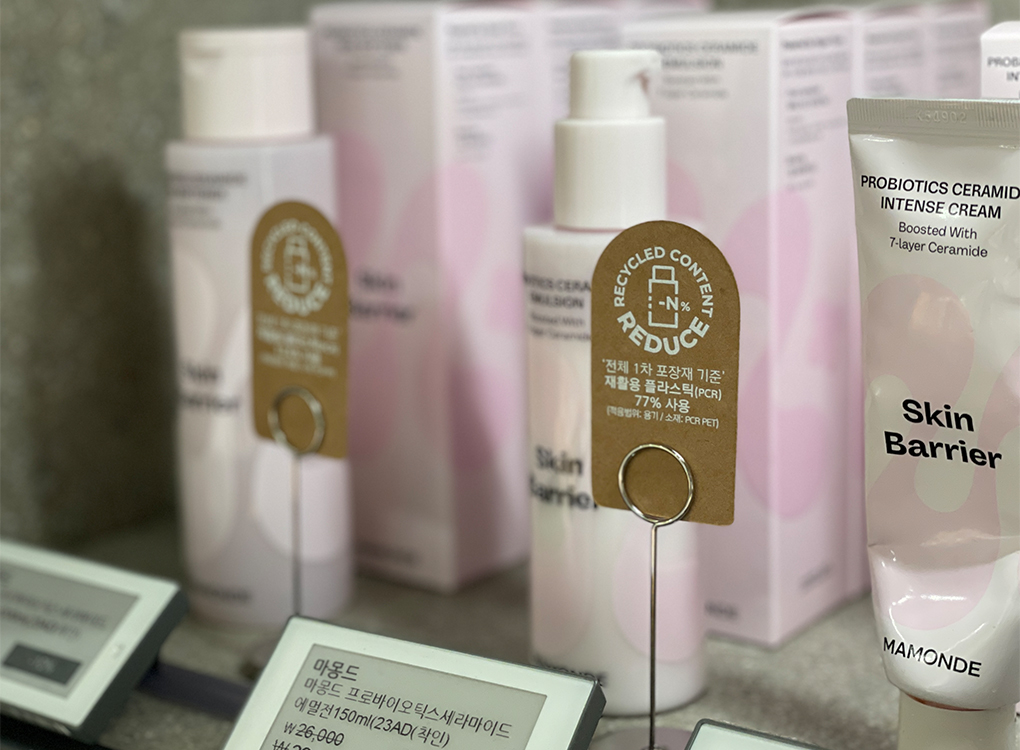
Source: Labels for 3R products at Amore Seongsu
I can’t help but reconsider the product development process as well. The various efforts by brands that create products using post-consumer recycled plastic (PCR), despite higher costs, and consistently launch refill products despite limited demand, certainly deserve applause. When I see companies boldly introducing paper materials instead of plastic or showcasing new technologies that aid recycling, I definitely sense the potential for innovation. Nevertheless, these efforts don’t seem to have become the standard that companies must follow across the board. Instead, I often encounter the unfortunate situation where well-intentioned efforts aren’t sufficiently recognized and get caught up in criticism for greenwashing. As a result, some products avoid highlighting these efforts, fearing they might face unnecessary misunderstanding and criticism.
Of course, society’s overall awareness and interest in “eco-friendliness” has increased substantially compared to the past. According to various research studies from Statista, Kantar, and others, the sustainable beauty market has already grown to nearly 30% globally and continues to expand steadily at a rate of 7-9% annually. However, in Korea’s case, this ratio still remains below 10%, which is disappointing compared to global trends. I honestly admit that while I carefully examine and scrutinize “better quality” or “safer ingredients,” I still treat “more eco-friendly products” as an option I choose only when various conditions allow.
3 “The thought that without changes to markets and systems, we’ll remain stuck where we are.”
This line of thinking naturally led me to broader social and economic structural issues. The capitalist system brought by the Industrial Revolution has, over the past centuries, delivered unprecedented prosperity and innovation to humanity while also casting a shadow of unsustainable growth paths. This accumulated foundation of capitalism has become the root of the serious problems we face today, such as climate change and biodiversity loss. I initially considered individual and corporate-level practices, but eventually felt their limitations. I came to believe that sustainability would remain elusive without fundamental changes to systems and market structures.
I began to strongly resonate with voices calling for a system that rewards genuine value creation for society and the environment, rather than capitalism focused solely on “financial value extraction.” Such a transformed system would serve as the catalyst for sustainability and resilience in our current era. This made me acutely aware of the urgent need for “internalization” – properly evaluating and reflecting all environmental and social costs and benefits within our economic and social systems.
As this perspective has gained traction, new laws and regulations that strengthen ESG (Environmental, Social, and Governance) are emerging globally. Market paradigm shifts toward stakeholder-centered approaches, beyond shareholder value, are gaining momentum, and policies promoting environmental impact disclosure, such as the EU’s Digital Product Passport (DPP) and Korea’s Act on Promotion of Transition to Circular Economy and Society, are becoming a reality. While the convergence of these changes over just a few years can sometimes feel overwhelming, I believe the overall trajectory is positive.
Source: Information on products’ environmental impacts at Amore Yongsan
3 “When hidden costs become visible” : Making environmental impact costs visible across product lifecycles
I discovered a breakthrough for overcoming the fundamental limitations I felt in eco-friendly practices and product development through the power of “information and data.” If we could see the specific environmental impacts and their costs at every stage of a product’s journey – from raw material production through packaging, manufacturing, distribution, consumption, to disposal – both companies and consumers could make much better decisions. For example, when considering whether to use post-consumer recycled plastic (PCR), which costs much more than conventional plastic during product development, the stereotype that “recycled plastic is always expensive” could change if we factor in not just simple cost differences but also recycling fees, plastic taxes, and social and environmental externalities from various countries.
While preparing this column, I used the international standard ISO 14008 (Monetary Valuation of Environmental Impacts and Related Environmental Aspects) to convert 16 different environmental impacts across the lifecycle of our company’s approximately 4,000 products (greenhouse gas emissions, water usage, eutrophication, ecotoxicity, acidification, ozone depletion, particulate matter formation, ionizing radiation, land use, resource depletion, etc.) into monetary costs. The results showed that some products had social and environmental costs of only around 10,000 won per unit, while others exceeded 300,000 won. While data quality and accuracy still have limitations, these quantified results alone gave me confidence that we could consider much more diverse experimental approaches and changes in the future.
When these lifecycle social and environmental impact costs become apparent, efforts to reduce them will enhance each product’s and brand’s differentiation while driving innovative product development. Furthermore, if products and brands with lower social and environmental impacts lead market transformation, this virtuous cycle will gradually spread, fundamentally changing market structures and ultimately bringing more positive transformation to our society as a whole.
Source: Posters at Amore Yongsan for AMORE:CYCLE Pop-up in October 2024
#OUTRO
I’ve recently come to realize that positive currents I initially couldn’t see do exist, with seeds of change hidden within them. I’ve also come to feel that everyone is making their efforts in their ways and places, and I’ve acknowledged that I, too, need to slightly adjust the areas where I focus and think.
Recently, since I’m not confident I can carry an eco-bag 130 times, I’m trying a minimalist lifestyle where I don’t carry bags at all. This has made my life feel lighter and freer. I’ve also stopped buying plastic water bottles and started boiling my water to drink. This change was driven more by health anxiety from news about microplastics than by environmental consciousness. Looking back, the changes that initially led to action weren’t driven by grand social causes, but rather by discomfort, health issues, and practical benefits that directly affected my life. Based on these thoughts, I want to adjust toward small but concrete and tangible actions rather than pursuing vague changes through practice. When change feels overwhelming, I plan to think more deeply about small, actionable systems or policies, such as nudges.
I realize that these attempts don’t always yield satisfactory results. Since change and innovation don’t happen overnight, I’m looking forward to that moment when countless attempts and small changes interlock, influence each other, and spread like waves.
 |

Yuna Hwang |
|
|
Amorepacific
|
|
-
Like
0 -
Recommend
0 -
Thumbs up
0 -
Supporting
0 -
Want follow-up article
0



